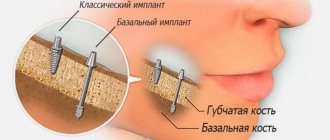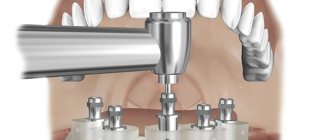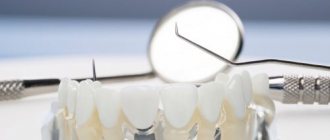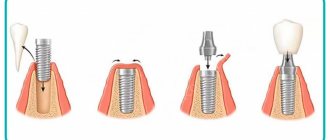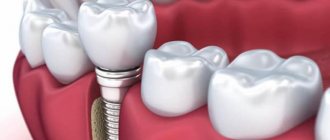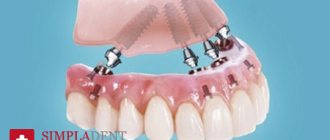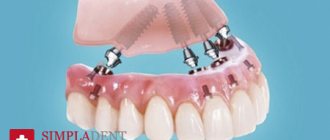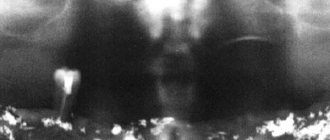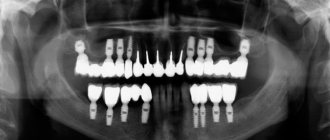Is it possible to restore teeth with implantation in one day?
A technique that allows you to quickly restore one or more missing teeth is called one-stage implantation and involves installing an implant and a temporary crown on it during just one appointment with a doctor. Moreover, the operation is performed transgingivally without making an incision in the gum and folding back its flap (dental implantation without an incision). It is worth mentioning one more technique, which is usually used in cases where a tooth destroyed as a result of injury or a long-term inflammatory process cannot be completely treated or restored with a crown or dental inlay. In such situations, which occur quite often, the tooth is removed, an implant is immediately installed in its place and it is loaded with a temporary crown, that is, a simultaneous implantation is performed.
Indications
Single-stage dental implantation and two-stage dental implantation are equally high-quality and effective concepts if the treatment is carried out by qualified specialists and high-quality implants, dentures and components are used. The Smile Estet clinic has all the components to solve clinical cases of any complexity. We practice the principles of teamwork: the surgeon, orthopedist and dental technician are in close contact and control all stages of treatment.
When drawing up a treatment plan, we not only focus on obvious indications, but also analyze each case from the point of view of anatomy, biomechanics and maxillofacial surgery. The chief physician of the Smile Estet clinic, Kochubey Alexander Alekseevich, is the developer of original treatment methods and one of the best specialists in one-stage implantation with immediate loading.
| Service | Price |
| Complex implantation on BIOMED | |
| Complete complex implantation with immediate loading of one jaw. Implant BIOMED (Switzerland) | 350 000 ₽ |
| Complete complex implantation with immediate loading of both jaws. Implant BIOMED (Switzerland) | 700 000 ₽ |
| One-stage implantation with immediate loading, segment up to 5 teeth. Implant BIOMED (Switzerland) | from 200,000 ₽ |
| One-stage implantation with immediate loading, segment up to 3 teeth. Implant BIOMED (Switzerland) | from 135,000 ₽ |
| Complex implantation on RADIX | |
| Complete complex implantation with immediate loading of one jaw. RADIX implant | from 350,000 ₽ |
| Complete complex implantation with immediate loading of both jaws. RADIX implant | from 700,000 ₽ |
| Complete restoration of teeth on 6 RADIX implants (All-on-6), one jaw | 250 000 ₽ |
| Complete restoration of teeth on 6 RADIX implants (All-on-6), both jaws | from 550,000 ₽ |
| Complete restoration of teeth on 6 RADIX implants (4 implants + 2 Zigoma), for the upper jaw | from 310,000 ₽ |
| Complete complex implantation with immediate load of the upper jaw RADIX + ZIGOMA 2 pcs. | from 350,000 ₽ |
| Complete complex implantation with immediate loading of the upper jaw. RADIX using the “ALL-ON-4” method | 200 000 ₽ |
| Complete complex implantation with immediate loading of the upper jaw. RADIX using the “ALL-ON-6” method | from 450,000 ₽ |
| One-stage implantation with immediate loading, Segment of up to 5 teeth. RADIX implant | from 230,000 ₽ |
| One-stage implantation with immediate loading, Segment of up to 3 teeth. RADIX implant | from 190,000 ₽ |
| Complex implantation at STRAUMANN | |
| Complete restoration of teeth on 6 STRAUMANN implants (All-on-6), one jaw | 400 000 ₽ |
| Complete restoration of teeth on 6 STRAUMANN implants (All-on-6), both jaws | 800 000 ₽ |
| Complex implantation on OSSTEM | |
| Complete restoration of teeth on 6 OSSTEM implants (All-on-6), one jaw | from 400,000 ₽ |
| Complete restoration of teeth on 6 OSSTEM implants (All-on-6), both jaws | from 750,000 ₽ |
| Consultation | |
| Appointment and examination by a dentist-therapist | from 1,000 ₽ |
| Appointment with a dental surgeon | from 1,000 ₽ |
| Appointment with an orthopedic dentist | from 1,000 ₽ |
| Appointment with an orthodontist | from 2,000 ₽ |
| Panoramic shot | |
| OPTG orthopantomogram (panoramic image) with recording on disk (take with you) | from 1,500 ₽ |
Consult
What are the advantages of one-stage implantation?
Firstly, with its help you can close the gap formed due to tooth loss with a reliable and aesthetic design and not be embarrassed about your smile. Secondly, a temporary dental crown immediately installed on the implant allows you to create an ideal gum contour and avoid the appearance of a very common defect during delayed implantation - black triangles - spaces between the artificial tooth and adjacent natural teeth not covered by soft tissue. And thirdly, one-stage implantation reduces treatment time by approximately half.
To attract clients, some clinics often call the one-stage method express implantation and promise to completely restore the patient’s tooth in one day. But you need to understand that during one appointment, the doctor can load the implant only with a temporary crown, and install a permanent one three to four months later. Loading an implant that is not yet fully stabilized in the bone with a fairly heavy permanent structure threatens, firstly, with its rejection, and secondly, with the occurrence of a rather dangerous defect. The fact is that after the operation the soft tissues are very inflamed and fit very tightly to the crown. After some time, the swelling subsides and a gap forms between the gum and the prosthesis, which is closed with a more suitable permanent crown. If you immediately install a permanent structure on the implant, the resulting gap will no longer be able to be closed. After some time, the gums will sink even more and expose the abutment, which will be very noticeable when you smile, and the bacteria accumulating on it will cause inflammation and, as a result, re-implantitis.
Indications and contraindications for the use of one-stage technology
Indications:
- missing one or more teeth;
- complete edentia;
- the need to restore a dental unit immediately after extraction (indication for immediate implantation)
Absolute contraindications:
- bone atrophy in the area of upcoming implantation;
- serious immune diseases (AIDS, HIV, etc.);
- tuberculosis;
- bone diseases;
- poor blood clotting;
- oncology;
- diabetes mellitus in the stage of decompensation;
- severe pathologies of the heart and blood vessels;
- mental problems.
Relative prohibitions:
- age under 18 years;
- vertical malocclusions;
- dental and periodontal diseases (including cysts and granulomas);
- allergy to anesthetics;
- pregnancy and breastfeeding;
- infectious diseases;
- alcoholism, drug addiction;
- general exhaustion of the body;
- depression.
Note: contraindications are called relative, because if they are eliminated, implantation can be performed.
Stages of one-stage implantation
1 Diagnostics
Visual and hardware examination (orthopantomogram, 3D tomography), identification of indications and contraindications.
2 Preparatory
Sanitation of the oral cavity (dental and periodontal treatment, professional hygiene)
3 Implantation
Surgery: local anesthesia, integration of a titanium rod into the patient’s jaw by screwing, installation of a temporary prosthesis
4 Osseointegration
Period of implantation
5 Dentures
Fixation of permanent dentures
Important: one stage instead of two still does not allow you to give a full load (place a permanent prosthesis) on the implanted artificial root immediately after its installation. This threatens implant rejection. Therefore, the final fixation of the prosthetic structure is performed only upon completion of the osseointegration process, i.e. after 3 to 6 months.
What is better: classic two-stage implantation or one-stage implantation?
It is, of course, best to restore the front teeth using a one-stage technique, but the presence of contraindications does not always allow it to be carried out. In such cases, we resort to a two-stage technique, which is also one of the most effective methods of prosthetics. Therefore, it is impossible to call any of the above methods the best. It is important to understand which one will be most acceptable and safe for the patient. However, let us outline all the advantages of one-stage implantation:
- the ability to complete the entire procedure in a short period of time;
- use of local anesthesia only;
- the ability to carry out installation, even with complete or partial absence of teeth;
- absence of invasive and painful surgical intervention;
- the possibility of performing the procedure even with a small amount of bone tissue;
- installation of an implant immediately after tooth extraction;
- the ability to perform chewing movements on the day of the procedure;
- relatively low cost.
Advantages and disadvantages
The main advantage of the technology under consideration is the possibility of almost instant restoration of the aesthetics of the dentition. The color of the temporary prosthesis is matched to the shade of the natural enamel of the adjacent elements, so the crown (“bridge”) fits perfectly into the dentition. The fact that surgery is performed only once when installing an implant is also positive. In addition, the temporary prosthetic structure does not allow the gum in the defect area to recede, thereby worsening the aesthetics of the smile. Another important advantage is the reduction of time spent on implant-supported dentures (compared to the two-stage method). The disadvantages of this method include the presence of many limitations, including the lack of bone tissue in the integration zone.
The network of dental clinics “Smile” offers patients single-stage dental implantation services. Contacting our branches has significant advantages:
- operations are performed by highly qualified surgeons;
- all dental procedures are carried out in accordance with international standards;
- family and cumulative discounts are provided;
- pricing of services depends on the characteristics of the clinical case and the cost of the implantation system;
- We work according to a schedule convenient for patients: every day until 21:00 (on Sunday until 16:00).
You can make an appointment at any of the branches of our clinic in Moscow, located within walking distance from metro stations:
- Alekseevskaya (VDNKh district, etc. Mira), address: st. 3rd Mytishchiskaya house 3, building 2;
- Shelepikha, address: Shelepikhinskaya embankment, address: building 34, building 1.
The use of the latest technologies, extensive practice and equipping the clinic with modern equipment allow us to successfully perform dental implantation using any method, regardless of the complexity of the clinical situation. We guarantee the safety and effectiveness of the services provided. We will restore the attractiveness of your smile!
What's included in the price
Our Center has developed a case-based “turnkey” payment system. One-stage implantation combines cases of implantation and installation of a crown or prosthesis.
The implantation case includes:
- local anesthesia
- implant and its installation
- auxiliary operations for basic bone tissue augmentation, including regeneration stimulators
- applying and removing sutures
- postoperative examinations and control 3D images during the rehabilitation period
- antibiotics, painkillers (delivered at home)
The cost of a case for installing a crown or prosthesis includes:
- taking impressions
- abutment
- crown or denture
Two-stage prosthetics with implants
Two-stage implantation is a classic method of prosthetics, in which, at the first stage, implants are installed on the patient, and the prostheses themselves are placed only a few months later, after the artificial root has engrafted and fused with the bone (osseointegration).
The peculiarity of the technique is that plugs are placed on the upper part of the implant, and the entire structure ends up under the gum and is not visually visible.
At the second stage, when the patient is fitted with dentures, the gum is re-incised, the abutment is screwed onto the post, and the crown is screwed onto it.
The two-stage protocol involves more trauma, but it has a number of advantages:
- optimal survival rate;
- long service life of implants;
- two-stage implantation is possible even when there are contraindications to a one-stage procedure;
- the ability to restore both one individual tooth and all teeth in a row;
- lower requirements for the condition of the dental system and the quality of bone tissue;
- fewer contraindications.
IMPLANTATION STAGES WITH IMMEDIATE LOADING
- preparing the patient and oral cavity for surgery;
- modeling of an individual design of implants to suit the specifics of the patient’s case.
- If there are movable teeth that cannot be restored, they are removed and implants are immediately installed in their place.
- If teeth are already missing, then the bed is formed using a puncture method, and then the implants are implanted into the bone using the compression method;
- The orthopedic doctor makes an impression, models and manufactures the prosthesis;
- the tops of the implants (abutments) are fixed at the required angle for subsequent installation of the prosthesis;
- on the third day after implantation, a permanent metal-plastic prosthesis is installed on the structure, which is adjusted to the patient’s bite;
- the patient can begin to use the new teeth.
VIDEO REVIEWS OF PATIENTS - WATCH HOW THE OPERATIONS GO
Fast implantation is not fast rehabilitation, why?
With a long “toothless” period, the bite changes, the relationship of the jaw bones is disrupted, and the joint and muscles are also involved in the changes. When the replacement of defects is completed, the chewing load will be distributed differently and the jaw will have to adapt. Recovery lasts until the jaw joint takes the desired position and the muscles relax.
Recovery time can be quite long, regardless of whether the implant was installed immediately or according to the standard procedure.
Making dentures quickly and cheaply is not a difficult task. Making them not only functional and aesthetic, but also durable is not an easy task and requires a doctor to have enormous experience, intuition, great fundamental knowledge and skills, which means it cannot be cheap. Unfortunately, there are not many such specialists, but some of them work in our clinic.
How to get high-quality dentures on implants
- Original components (prosthetics).
Often, implantation systems use either counterfeit components from China or prosthetics manufactured in their own laboratory. But you need to understand that it is impossible to repeat the original quality of a metal alloy. - Our clinic uses only original components of the ROOTT system. That's why we provide a lifetime warranty on all components used.
- Highly qualified dental technician.
Making highly aesthetic dentures is a unique art, good taste, knowledge of anatomy and engineering. Our technicians have all this knowledge and know how to apply it. A highly qualified technician is as scarce as a competent doctor. - Laboratory with all equipment.
Digital technologies and high-precision machines help make prosthetic structures of maximum functionality and aesthetics. - A competent doctor
is a leader at all stages of prosthetics: preparation of the oral cavity, implantation, management of all stages of treatment. A qualified doctor will determine which teeth can be saved and which need to be replaced with implants to maintain the patient's quality of life.
In our clinic we have gathered the best specialists, whose experience, equipment and high-quality materials allow us to obtain the expected result.
Voznyuk Vladimir Aleksandrovich Implant surgeon, doctor of the highest category
I am facing removal of my two lower teeth due to a large cyst between the roots. Is it possible to immediately place one-stage implants?
First of all, it is necessary to check how much the cyst has destroyed the bone tissue of the tooth root. Perhaps there is the possibility of simultaneous implantation. If the stabilization of one-stage implants is in question, it is better to remove the teeth, wait until the wound heals and the bone tissue is restored, and then carry out one-stage implantation.
Contraindications
One-stage implantation is not possible if:
- diseases of bone tissue (osteoporosis);
- inflammatory diseases of periodontal and periodontal tissues;
- large width of the socket of the extracted tooth (the implant cannot be firmly fixed);
- formations in tissues - cysts, granulomas;
- atrophic changes in bone tissue, alveolar processes.
Both one- and two-stage implantation are not performed in case of general surgical contraindications and a number of diseases and conditions:
- diseases of the blood, blood-forming organs, coagulation disorders;
- mental illness;
- oncological diseases;
- allergic reactions - to anesthetics, drugs and materials used;
- endocrine pathologies;
- severe diseases of the cardiovascular system;
- HIV;
- connective tissue diseases.
Relative contraindications to two-stage implantation are:
- changes in the tone of the chewing muscles (requires preliminary treatment, correction), the need for sanitation of the oral cavity (caries, gum inflammation, periodontal disease),
- smoking,
- some bite defects,
- exacerbation of chronic diseases,
- the use of certain medications that change the composition of the blood or are incompatible with anesthesia drugs,
- insufficiently good oral hygiene.
